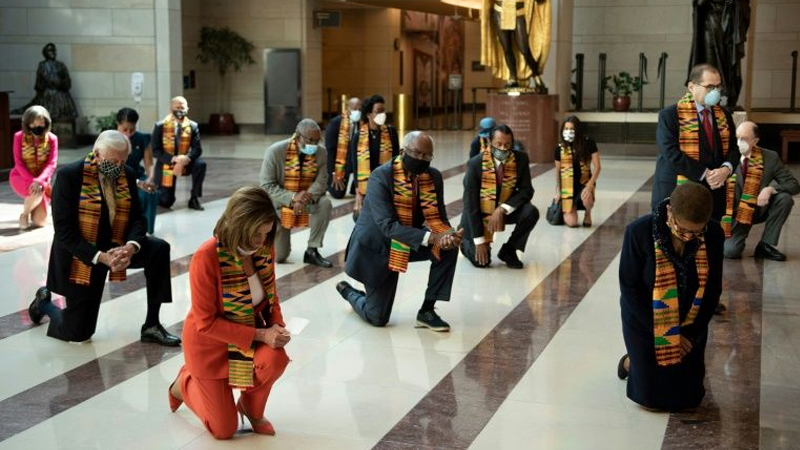Fact check: Yes, Kente cloths were historically worn by empire involved in West African slave trade

The claim: Kente scarves worn by Democrats were historically worn by rich African slave owners and traders
On June 8, Democratic members of Congress wearing kente cloths and face masks knelt in Emancipation Hall to memorialize Black lives lost to police brutality. House Speaker Nancy Pelosi, D-Calif., read the names of unarmed Black people who’ve recently been killed by police.
“We were there for eight minutes and 46 seconds on our knees,” she told reporters afterward . “My members will attest, it’s a very long time. It’s a very long time.”
The group then introduced the Justice in Policing Act of 2020, aimed at changing policing after a series of Black individuals killed by police officers led to weeks of protest in the U.S. and overseas.
In the days since, social media users have pointed out the cloth’s historical ties to the slave trade in order to criticize the legislators’ garment choice.
“Yesterday the Democrats wore kente scarfs and knelt down for their photo op. So check this out, Kente cloth was worn by the Ashanti. It’s made of silk so the affluent wore it. The Ashanti were also known as slave owners and traders. Huh?” Dave Brandon posted on Facebook June 9. “This makes me wonder why they chose to wear this particular tribe’s garb.”
In the Facebook post, Brandon acknowledges kente cloth’s historical ties to the slave trade; however, he ignores the broader cultural significance the cloth has to West African and African American culture.
Brandon has not responded to USA TODAY’s request for comment.
The origin of kente cloth
Kente cloth comes from the Asante, or Ashanti, peoples of Ghana and Ewe peoples of Ghana and Togo.
A popular legend claims creators of kente cloth presented the cloth to Asantehene Osei Tutu, the Asante kingdom’s first leader. Tutu named the cloth “kente,” meaning basket, and adopted the fabric as a royal cloth for special occasions.
The Asante and slave trade
Tutu, who lived from 1660 to 1712 or 1717, unified several small Asante kingdoms to create the Asante empire. He is credited with expanding the Asante throughout most of Ghana and introducing his subjects to the gold and slave trades along the West African coast.
The Asante supplied British and Dutch traders with slaves in exchange for firearms, which they used to expand their empire. Slaves were often acquired as tributes from smaller states or captured during war. Some slaves were brought across the Atlantic whiles others stayed in Africa to work in gold fields.
According to the BBC, by the end of the 18th century, the region exported an estimated 6,000-7,000 slaves per year.
Kente cloth has historical significance beyond slave traders
The Ultimate History Project has pointed to the Pangi cloth woven by the Maroon people of Suriname as evidence of kente’s cultural significance beyond slave traders.
Suriname, formerly Dutch Guiana, is a small nation on the northeastern coast of South America. Suriname gained its independence from the Netherlands in 1975. Suriname’s Maroon people are the descendants of escaped African slaves.
The Maroon people wear Pangi, which has similar patterns and colors to kente cloth. Historians believe the Maroons derived Pangi from kente cloths and their Asante culture.
Cultural Specialist and Senior Curator at the Smithsonian Center for Folklife and Cultural Heritage Diana Baird N’Diyea spoke to USA TODAY about the broader historical context and cultural significance of kente cloth.
N’Diyea, who did field research with the Maroon people in Suriname, agreed formerly enslaved people that were likely Asante used kente’s technique and aesthetic to create Pangi.
“It’s complicated because there’s a lot of evidence that people from all social groups and classes were enslaved,” N’diyea told USA TODAY.
